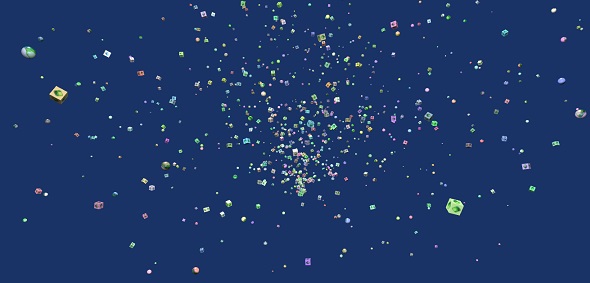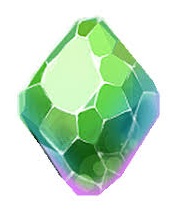
- BabylonJS - Home
- BabylonJS - Introduction
- BabylonJS - Environment Setup
- BabylonJS - Overview
- BabylonJS - Basic Elements
- BabylonJS - Materials
- BabylonJS - Animations
- BabylonJS - Cameras
- BabylonJS - Lights
- BabylonJS - Parametric Shapes
- BabylonJS - Mesh
- VectorPosition and Rotation
- BabylonJS - Decals
- BabylonJS - Curve3
- BabylonJS - Dynamic Texture
- BabylonJS - Parallax Mapping
- BabylonJS - Lens Flares
- BabylonJS - Create ScreenShot
- BabylonJS - Reflection Probes
- Standard Rendering Pipeline
- BabylonJS - ShaderMaterial
- BabylonJS - Bones and Skeletons
- BabylonJS - Physics Engine
- BabylonJS - Playing Sounds & Music
BabylonJS - Mesh SolidParticles
SolidParticle System is updated on a mesh. All the properties that we have seen on a mesh can be used on the solid particle.
In the demo given below, we have created standard material and assigned it to box and sphere.
To create the solid particle system, execute the following command −
var SPS = new BABYLON.SolidParticleSystem('SPS', scene);
SPS.addShape(sphere, 500);
SPS.addShape(box, 500);
var mesh = SPS.buildMesh();
To add particles to the system, use the addShape method. It takes parameters like the shape, i.e., the mesh to be added and how many.
In the demo link, we will add the sphere and the box. The count is 500 which means 500 spheres and boxes.
sphere.dispose(); // free memory box.dispose();
The dispose () method helps to free the memory which is done as shown above.
Particles property
Let us now see how the particle property works −
var speed = 1.5; var gravity = -0.01;
We are using the following methods on particle system in our demo −
initParticles − This method helps to initialize the particles. SPS.nbParticles gives the all the particles available.
recycleParticle − You can recycle the particle using this method.IT contains details of a single particle.
updateParticle − Allows to update the particle properties.
Play around with the demo provided and you can change the properties and see the output.
Demo
<!doctype html>
<html>
<head>
<meta charset = "utf-8">
<title>BabylonJs - Basic Element-Creating Scene</title>
<script src = "babylon.js"></script>
<style>
canvas {width: 100%; height: 100%;}
</style>
</head>
<body>
<canvas id = "renderCanvas"></canvas>
<script type = "text/javascript">
var canvas = document.getElementById("renderCanvas");
var engine = new BABYLON.Engine(canvas, true);
var createScene = function() {
var scene = new BABYLON.Scene(engine);
scene.clearColor = new BABYLON.Color3( .1, .2, .4);
var camera = new BABYLON.ArcRotateCamera("camera1", 0, 0, 0, new BABYLON.Vector3(0, 0, -0), scene);
camera.setPosition(new BABYLON.Vector3(0, 50, -300));
camera.attachControl(canvas, true);
var light = new BABYLON.HemisphericLight("light1", new BABYLON.Vector3(1, 1, 0), scene);
light.intensity = 0.9;
var pl = new BABYLON.PointLight("pl", new BABYLON.Vector3(0, 0, 0), scene);
pl.diffuse = new BABYLON.Color3(1, 1, 1);
pl.specular = new BABYLON.Color3(0.2, 0.2, 0.8);
pl.intensity = 0.75;
// texture and material
var url = "images/gem1.jpg";
var mat = new BABYLON.StandardMaterial("mat1", scene);
var texture = new BABYLON.Texture(url, scene);
mat.diffuseTexture = texture;
// SPS creation
var sphere = BABYLON.Mesh.CreateSphere("sphere", 32, 2, scene);
var box = BABYLON.MeshBuilder.CreateBox("box", { size: 2 }, scene);
var SPS = new BABYLON.SolidParticleSystem('SPS', scene);
SPS.addShape(sphere, 500);
SPS.addShape(box, 500);
var mesh = SPS.buildMesh();
mesh.material = mat;
mesh.position.y = -50;
sphere.dispose(); // free memory
box.dispose();
// SPS behavior definition
var speed = 1.5;
var gravity = -0.01;
// init
SPS.initParticles = function() {
// just recycle everything
for (var p = 0; p < this.nbParticles; p++) {
this.recycleParticle(this.particles[p]);
}
};
// recycle
SPS.recycleParticle = function(particle) {
particle.position.x = 0;
particle.position.y = 0;
particle.position.z = 0;
particle.velocity.x = (Math.random() - 0.5) * speed;
particle.velocity.y = Math.random() * speed;
particle.velocity.z = (Math.random() - 0.5) * speed;
var scale = Math.random() +0.5;
particle.scale.x = scale;
particle.scale.y = scale;
particle.scale.z = scale;
particle.rotation.x = Math.random() * 3.5;
particle.rotation.y = Math.random() * 3.5;
particle.rotation.z = Math.random() * 3.5;
particle.color.r = Math.random() * 0.6 + 0.5;
particle.color.g = Math.random() * 0.6 + 0.5;
particle.color.b = Math.random() * 0.6 + 0.5;
particle.color.a = Math.random() * 0.6 + 0.5;
};
// update : will be called by setParticles()
SPS.updateParticle = function(particle) {
// some physics here
if (particle.position.y < 0) {
this.recycleParticle(particle);
}
particle.velocity.y += gravity; // apply gravity to y
(particle.position).addInPlace(particle.velocity); // update particle new position
particle.position.y += speed / 2;
var sign = (particle.idx % 2 == 0) ? 1 : -1; // rotation sign and new value
particle.rotation.z += 0.1 * sign;
particle.rotation.x += 0.05 * sign;
particle.rotation.y += 0.008 * sign;
};
// init all particle values and set them once to apply textures, colors, etc
SPS.initParticles();
SPS.setParticles();
// Tuning :
SPS.computeParticleColor = false;
SPS.computeParticleTexture = false;
//scene.debugLayer.show();
// animation
scene.registerBeforeRender(function() {
SPS.setParticles();
pl.position = camera.position;
SPS.mesh.rotation.y += 0.01;
});
return scene;
};
var scene = createScene();
engine.runRenderLoop(function() {
scene.render();
});
</script>
</body>
</html>
Output
The above line of code generates the following output −

In this demo, we have used image gem1.jpg. The images are stored in the images/ folder locally and are also pasted below for reference. You can download any image of your choice and use in the demo link.
images/gem1.jpg
